Aquarius is a drum box that reacts to triggers and modulations.
The whole pack is a “macro-modular ensemble”, made of several devices for different functions, that can be used together or independently.
The principle is to use LFOs and step sequencers to generate drum triggers. Then, modulations can be used to modulate the drum synth sounds.
There is no “grid” and the process is much more like the “analogic” or “modular” experience.
You can use Aquarius with automatic drum generation and with midi notes, like with most other Scope drum boxes.
The pack includes a midi-notes to trigger converter (TxM5), and you can also crossfade smoothly between your midi pattern, and Scope based/eurorack trigger-pattern with TxM5.
The devices are separated in order to save and optimize DSP usage.
Aquarius and LogiQ are big devices that can be used together and also independently, for more flexibility. it means you can save and mix presets of your kits and drum patterns.
A lot of presets are included to start. There are dozens of parameters that allow to get deep into the details. Aquarius also includes FM and classic oscillators with ADSR, that can do synth sounds when the adsr is set to long notes. LogiQ does all the triggering, but also the modulations. For example, it include 2 step sequencers that can be used to pitch these oscillators correctly. LogiQ also includes a pitched oscillator that can be used for FM. And 7 LFOs and 4 LFO mixers to generate wild synth patterns.
All this is not often seen before, be it Scope/Xite or anywhere else.
To date, Aquarius LogiQ is made of :
TxM 5 crossfaders
General workflow
Integration
Other cool sounds with effects
Aquarius Auto-drummer+ Retro 5 midi sequence. Live workflow.
Retro 5 sound preview
Basically, you get first class DSP drum sounds that can be automatically generated or played by midi, or triggered by various means.
Aquarius Drum Modules are different from other drum generators and present many modulation inputs, for filters, envelopes and other parameters. They are based on the “LBH VIII” drum triggers for Scope PCI, but reworked and expanded.
It is easy, fun and results can either be unexpected or highly controlled, depending on your mood.
LogiQ is an automatic trigger and modulation generator. It creates rythms by mixing modulators rather than inserting points in a grid. The method is similar to the way synth sequences were generated in the 70’s/80’s, with additional functions to optimize triggering as well as modulations. You will find this vintage flavor in the drum sequences that are generated. You will get pop/groove/electro drums without thinking about a particular result, by mixing LFO’s and modulators together. It will always generate a coherent rithm, with enough variety to present unexpected results. LogiQ also includes an modulated oscillator as a modulator, which can be used to modulate Aquarius FM Percussion.
A good number of presets allow you to start and edit a few parameters to get a result that is either a simple variation, or something radically different. You don’t need to think a lot, which is also the purpose of these devices.
And if you are a sound designer, then you will love having access to a high number of parameters that are fine-tuned and focused.
Aquarius adapts to various workflow.
The reason why it is made of 3 devices is because you do not always need all functions. If those functions are needed, they can be added by adding the required device in your project. It is great to begin with just LogiQ and Aquarius and see what you can get from automated drum patterns. Then, at a later stage, you will drag TxM5 to add complexity to your kicks and snares.
Also, by having 3 seperate device, the use-cases of LogiQ and TxM5 are extended by great length. So it’s all about giving more power to whoever needs it, while limiting oneself to minimal functions may help getting more focus and drive creativity into new paths.
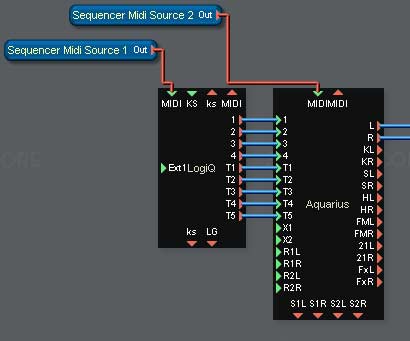
This is how Aquarius and LogiQ were initially intended to be used.
In this configuration, LogiQ provides the drumming and modulators while Aquarius takes care of the sound and drum mix. The only human intervention would be on tweaking various parameters with a midi hardware controller or a DAW.
Even though this setup is limited in terms of “complexity of the kicks”, it is advised to begin using both devices like this, because that’s how you will be driven to get the most out of LogiQ and come up with “happy accidents”.
What is great, is that you don’t really need to know what you are doing to get results. LogiQ looks impressive because of the high number of knobs and buttons, but it is just modulators that you mix together to reach a result that is usually not the kind of result you acheive by hand. This is waves and frequencies expressing themselves to create something of their own.
LogiQ can sync to itself but can also sync to incoming notes-on. The incoming notes-on can also be the root key of the “P3” 8 step pitch sequencer (CV or DSP format) and of the Val Sequencer which is also “DSP Pitch compatible” over 8 octaves (96 notes).
Aquarius can be connected to its own midi controller on its own midi source. However, it could perfectly share the same midi channel as LogiQ.
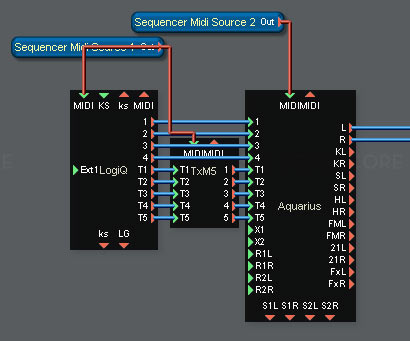
TxM5 is connected between the triggers ins and outs.
Now, you can assign your triggers to midi notes and play aquarius with any midi device such as keyboards or midi drum pads and groove boxes.
You can also crossfade between the midi triggers and LogiQ’s triggers, which not only gives access to the two patterns, but also allows to mix them to find new rythms without doing anything more than turning a crossfader knob.
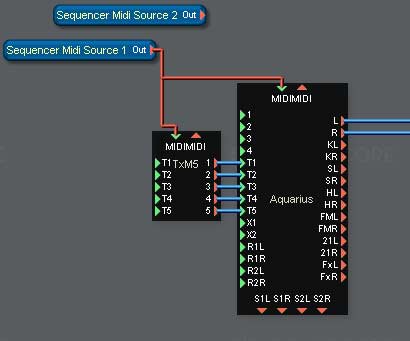
In this setup, Aquarius is not connected to any modulator (inputs 1-4 are not connected).
But is connected to TxM 5 , so it can be played with any midi device.
In such a setup, Aquarius will react like a classic un-modulated drum box (like a TR808 or like a sample player). You can still modulate many parameters of each drum section manually.
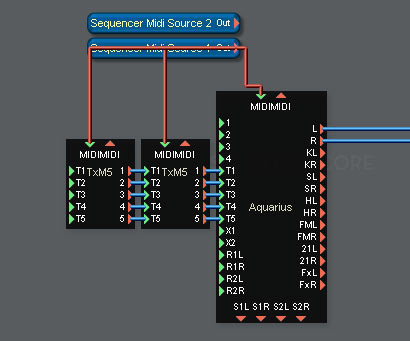
A simple extension of the above idea.
In this setup, two TxM5 are connected together and the midi DAW or device plays two midi patterns at the same time, on same or different midi channels (each device can receive on different individual notes so it does not matter wether the TxM5 are on same or different midi channels. The two patterns could even be on the same piano roll of a unique track of your daw (but that would not be easy to edit).
Then, with the crossfaders of the 2nd TxM5, it is possible to crossfade from a patterns to another.
Uising the crossfader of the 1st TxM5, you will have a “mute” (as nothing is connected to its T1-T5 inputs, it will send “nothin,g” to Aquarius)
It means that, by playing with just 2 crossfaders, you can have a verse and a chorus running all through your song in your daw, and you would be able to change from one to another “live” whenever you want in TxM5. Also, you can mix them together and find new variations. And you can mute everything too.
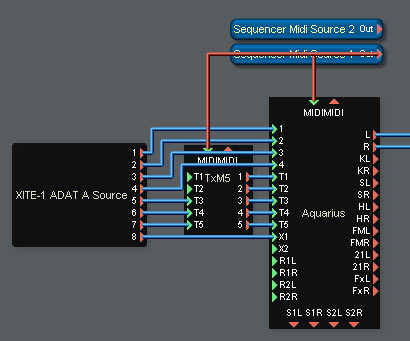
This setup requires one or several “CV to Adat” or “CV to Audio” hardware converters provided by third parties.
Here, most modulations and triggers come from eurorack sequencers and triggers.
A TxM5 is used to control the kick and snare only with a midi groove box or DAW.
The 8th adat ouput from the rack is routed to the X1 input (modulator).
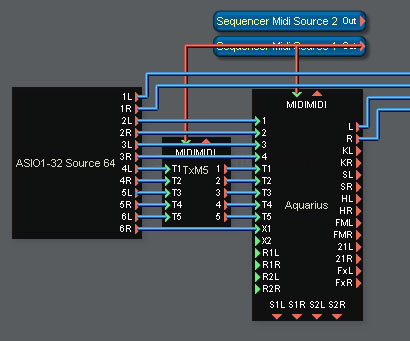
The Asio mix goes to a mixer, and all other asio outputs are routed to Aquarius, either directly or through a TxM5 in order to also send midi events as triggers or modulators.
Note that the X1 and X2 inputs of Aquarius are extra modulation inputs.
The “ks” output will send the tempo, while the “LG” output can send a gate every x measures, allowing both LogiQ and KrOn to be in sync when not using any note-on trigger.
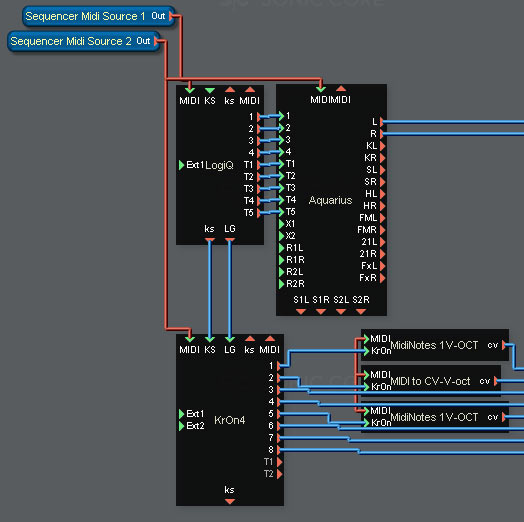
The image below shows how LogiQ is loaded by default. The manual “click” on the button can be mixed with the Self-Gate, and it will also restart the self-gate when pressed.
The KrOnSync button is for slaved devices only, so it should be activated only on KrOn.

Just load your project and it will sync automatically as soon as LogiQ sends its gate. By default, LogiQ is set to 4 measures, and can send a gate every 2 / 4 / 6 / 8 measures (8 measures in LogiQ are similar to 128 steps of KrOn when the tempo and divisors are the same on both devices).
If you are using a DAW or other midi devices, it is better to sync LogiQ and KrOn to note-on. The auto-sync mode is mainly for using all the connected devices without the need for any external midi device or sync.
Note that KrOn can accept more Gates through the Ext 1 and Ext 2 inputs, which are usable to restart the Quad sequencer. This will be helpful as these sync features are being further developped.
This project uses Aquarius, LogiQ, Retro 5, KrOn, and JunZ, Prodyssey CV with 3 voices, Magma, BB Osc 3, and Vectron. There is is still ressources and more synths or inputs could be connected to Aquarius or Retro 5 return inputs (R1 L/R, R2 L/R) (4 unused stereo inputs in total).
Or a few synths could be grouped in a sub mixer connected to one stereo input of Mix 12. You will find “Mix 12” and “Mix 3S” in the download page of this site.
The demo includes Aquarius and LogiQ only. It is the same version as the ones you can purchase.
After installation, you will need to request a demo key to Sonic Core. The demo allows for 100 hours for free. You will have to wait until the 100 hours expire to be able to request an full activation key (this is generally not a problem as I can send you a TxM5 that will run on both your demo and full key).
After Purchase, please fill in the Activation form on this page